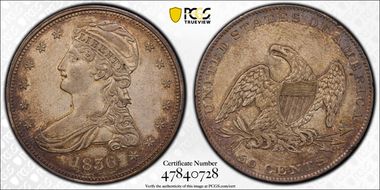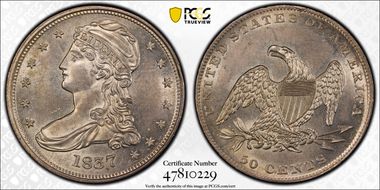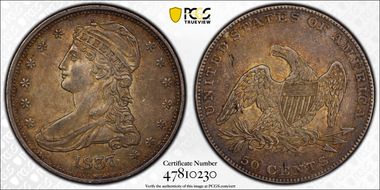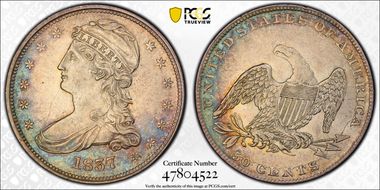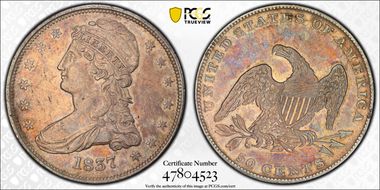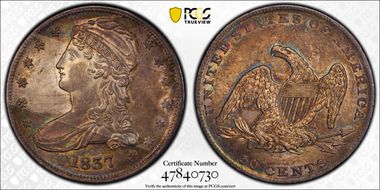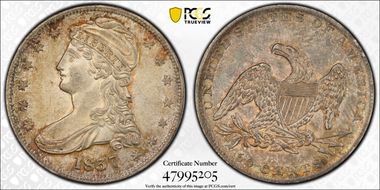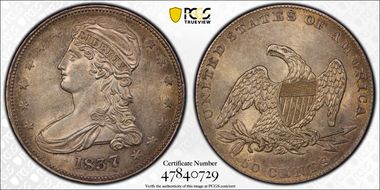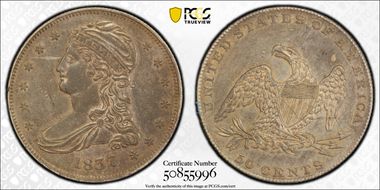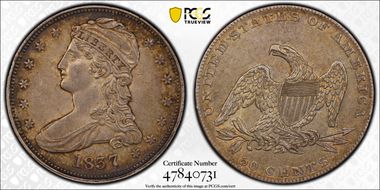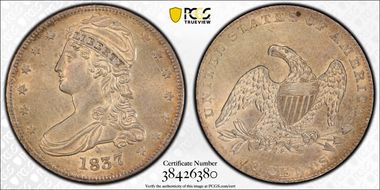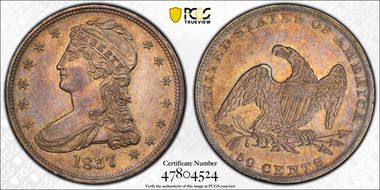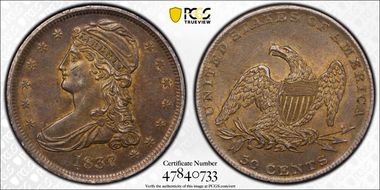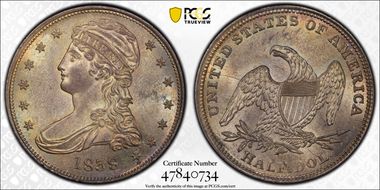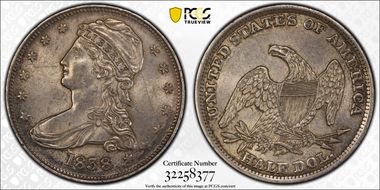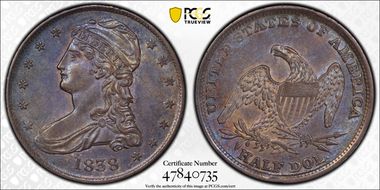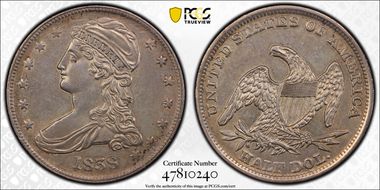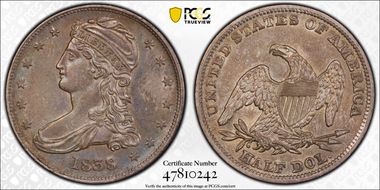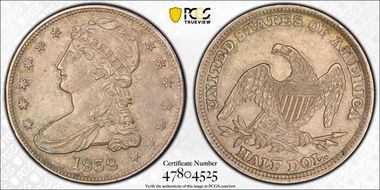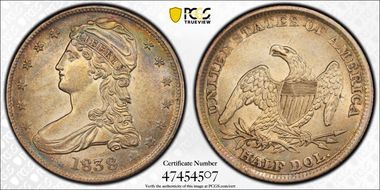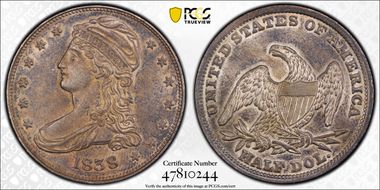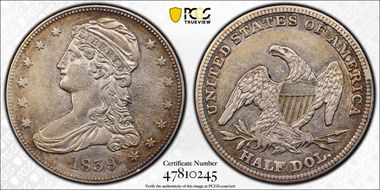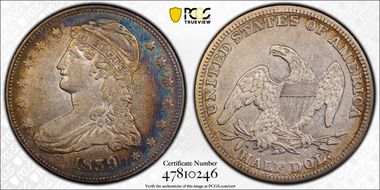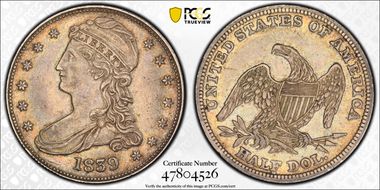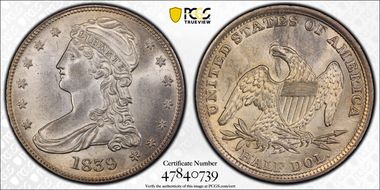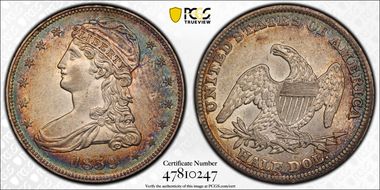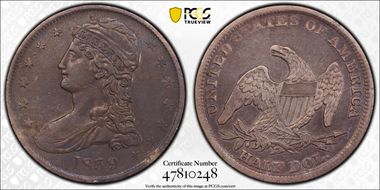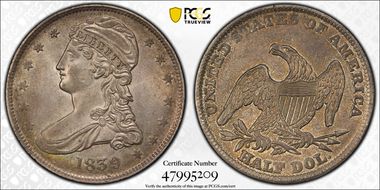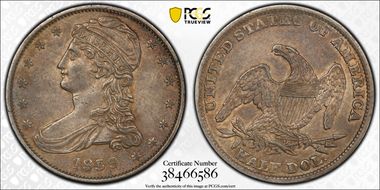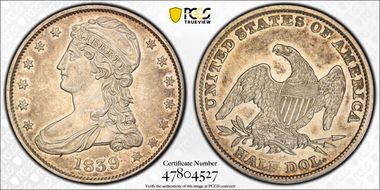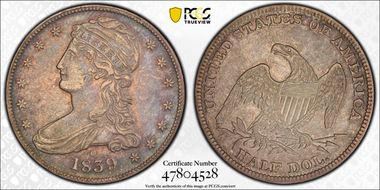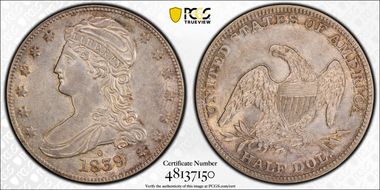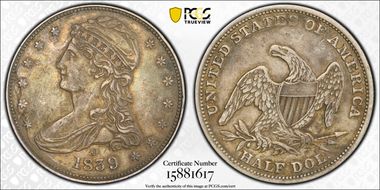HCumberdale 的钱币相册
An early die state coin with generally sharp stars and a very original look, GR-1 Rarity-2 The only known variety for the date. Total Mintage: approximately 5,000 pieces. Famous for being an ultra low-mintage regular issue half dollar and also for being the first half dollar struck using the steam press which granted the eponymous reeded edge. The steam coining press was new technology for the United States and along with vastly increased production capabilities, it allowed for a upgraded security feature to discourage the shaving or clipping of a coin's edge for small amounts of metal. With steam power in effect, enough force was present for a planchet to be able to be struck within a collar, thus imparting reeding onto the edge as the metal flowed up into the dies and out into the collar; an all-in-one seamless process. For their predecessors, the Capped Bust lettered edge half dollars, planchets would first need to be prepared by applying lettering to the edges via a castaing machine. Afterwards, the obverse and reverse could be struck by screw press, though in my mind "squeezed" feels like more of an appropriate term. In any case, the production improvements were a game-changer for the United States Mint. With the screw press two workers could produce 12 coins a minute. With the steam press, 100 coins a minute were produced by just a single person. It was this increased production rate along with the opening of new branches that finally allowed the U.S. Mint to produce enough coinage to meet the demands of our nation, eventually leading to less reliance on foreign coinage and then culminating in the coinage act of 1857 which repealed legislation allowing the use of foreign coins as legal tender.
Late Die State Rarity-5 variety. Same reverse die as the 1836 Gr-1, so likely the first die pair coined for the year. Lustrous and very well struck. In the condition census for the variety, Graham's (2012) reference listed a 62 and a 61 ahead of this, with multiple 58s.
CAC Late Die State Rarity-3 variety An interesting variety because of the circular indentation in the bars of the shield on the reverse; this is the only die pairing that uses this reverse. Retoned fairly well but definitely secondary,
Late Die State Rarity- 2 variety Previously AU-58 (NGC). Condition Census for the variety, in Graham's (2012) reference he lists a 65 and 62 ahead of this, with multiple 58s. A rather pretty coin, with vivid blue and sea green peripheries on both sides. An original coin? Nope, but I like it for what it is,
Late Die State. Rarity-3 Variety. A tough coin to find nice. Graham in his (2012) reference lists the condition census as 66, 65, 61, 50 and down from there.
Early Die State Rarity-1 Variety My "top pop" here is a bit of a disappointment when you consider it isn't even a condition census coin as listed by Graham in his (2012) reference. That just goes to show you that most people do not get their coins in variety-specific holders.
CAC Mid Die State Rarity-2 variety Inverted G used for C in AMERICA on the reverse. Neat, but this is a common variety, so don't get too excited. I absolutely love this look that tells a story of how the coin was stored for decades.
Late Die State Rarity-4 variety Upgraded from a PCGS 58. Nice cartwheel luster. Even though this is a scarcer die variety, there are a handful of very nice Mint State coins reported on the condition census.
CAC, Late Die State, Rarity-4 Variety. The lump to the right of the eagle's right wing is a naked eye pick up and is unique to this and GR-11 (a rarity-5 variety) so if you see a coin in the wild priced as a type coin, I'd recommend snapping it up. This is a Condition Census coin as reported by Graham in his (2012) reference with (2) 64s, a 63 and a 62 ahead of it with multiple 58s. This coin came out of Graham's collection sold through David Kahn.
Late Die State Rarity-5 variety Graham listed a 60 and a 55 ahead of this in his (2012) census, but additional coins have come out since. Attractive retoning at the peripheries, obviously not an original coin, but not a bad coin, especially for the variety. Though this was listed as a Rarity-5 variety in the reference, I would probably suggest it is not as rare. I've owned a handful and sold a couple. I know others who have multiples on hand as well. That said, the typical survivor I've seen is anything but desirable (VF and EF details). These coins leave a lot to be desired so if you happen upon a nice AU or finer, I would snap it up.
CAC, Early Die State, Rarity-2 Variety. An easy variety to find nice, Graham's (2012) census is all Mint State coins. I'd recommend looking for early die state coins on this variety as that will be a bit more challenging.
Late Die State Rarity-1 variety Just a touch of color at the peripheries which helps the interest factor in my eyes. I own this variety in PCGS 63 as well, but haven't decided if that coin is a keeper or not.
Middle Die State Rarity-3 variety I rather like the look of this coin with colorful peripheries and a light "skin" across all surfaces. It's not perfect, but for a 55, I have little to fuss about.
Middle Die State. A Rarity-4 variety. Under the eagle's beak on the reverse someone crudely removed a tiny spot of corrosion. It's not a bad coin otherwise, and it's look "fits" within my set. I'd call it AU-53 without the "improvement".
Lot 7196 E. Horatio Morgan Collection; 11/2019 Stack's Bowers Galleries
CAC, Late Die State, Rarity-2 Variety. Mild cartwheel luster emerges from behind lightly toned surfaces. A bit of an unusual "look" but it can be genuinely appreciated if one is patient.




















